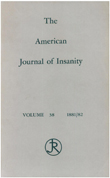Gender differences in diagnosing antisocial personality disorder in methadone patients
Abstract
OBJECTIVE: The goal of this study was to evaluate gender differences in the prevalence rates, short-term reliability, and internal consistency of the diagnosis of antisocial personality disorder for DSM-III-R, DSM- III, and Research Diagnostic Criteria (RDC). METHOD: A total of 37 men and 57 women methadone patients were diagnosed according to DSM-III-R, DSM-III, and RDC antisocial personality disorder criteria. RESULTS: The diagnostic rates, reliability, and internal consistency were lower for women than for men in all systems. DSM-III criteria resulted in the highest reliability for women, but for men, the DSM-III criteria were the least reliable. Examination of endorsement rates of individual antisocial personality disorder criteria revealed several significant gender differences on the majority of childhood criteria and on several adult criteria. Item-total correlations revealed that for women, the violent and aggressive childhood criteria in DSM-III-R that had not been included in DSM-III or RDC had a negative or no correlation to the assessment of antisocial personality disorder for women. CONCLUSIONS: The change in DSM-III-R from DSM-III childhood criteria appears to have resulted in a decrease in internal consistency and rates of antisocial personality disorder for women, but not for men. The results of this investigation indicate that the psychometric properties of the current antisocial personality disorder scales are weak for women, compared with men. To assess antisocial personality disorder in women it may be necessary to revise current, or develop new, diagnostic criteria.
Access content
To read the fulltext, please use one of the options below to sign in or purchase access.- Personal login
- Institutional Login
- Sign in via OpenAthens
- Register for access
-
Please login/register if you wish to pair your device and check access availability.
Not a subscriber?
PsychiatryOnline subscription options offer access to the DSM-5 library, books, journals, CME, and patient resources. This all-in-one virtual library provides psychiatrists and mental health professionals with key resources for diagnosis, treatment, research, and professional development.
Need more help? PsychiatryOnline Customer Service may be reached by emailing [email protected] or by calling 800-368-5777 (in the U.S.) or 703-907-7322 (outside the U.S.).



